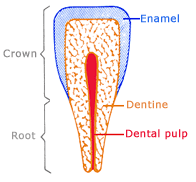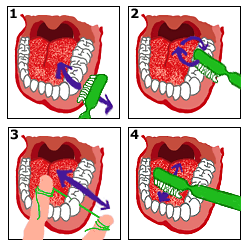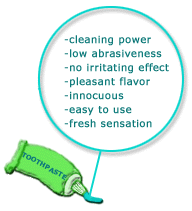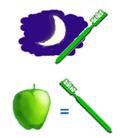Good dental hygiene and an adequate control of what we eat — especially sugar and soft foods — are effective prevention measures.
Dental caries is a multifactor disorder that does not heal spontaneously and causes gradual and irreversible destruction of the tooth.
The intervening factors are the diet, the dental tissues and the presence of microorganisms. Of these factors, diet is the easiest to control, and a fundamental first step for preventing the disease is simply correct tooth brushing.
In fact, caries are known to have affected humans to a greater or lesser extent since the Neolithic period, though the incidence has greatly increased with industrialization and the introduction of refined sugars.
According to the World Health Organization (WHO), combating caries is a priority. Indeed, it is regarded as a «worldwide plague» in view of its widespread incidence and the great number of people affected.
What are teeth like?
 |
We must take care of our teeth because they cannot be replaced.
A tooth consists of different parts: The enamel is the outermost layer of the crown. This part is very hard — even harder than bone. Beneath the enamel lies the dentine, which is not so hard, and beneath the dentine we find the dental pulp, which is sensitive to hot and cold foods, sweets or acids. |
Why do caries develop?
|
|
Bacteria and saliva intervene in caries production.
As has already been mentioned, a number of factors are involved in the formation of caries: foods, bacteria and constitutional factors characterizing each individual person. All of us have bacteria in the mouth. These bacteria cause no problems, and some are even useful. However, when we eat too much sweet or sugar-containing food, the bacteria use it as a source of energy, decomposing it and releasing acids which in turn attack the enamel of the tooth. These bacteria and the remains of food and sugar form so-called bacterial plaque, a film-like layer that covers the teeth and contains bacteria. This film facilitates the development of caries and diseases of the gums. |
Incidence
Caries are considered a worldwide plague.Dental caries are presently one of the most frequent infections in humans.
Updated data concerning the incidence of caries among the population: in construction.
Why should it be prevented?
|
Illustration: «World Health» journal (WHO) |
A sick tooth is a risk for the entire body.
Caries constitute an important health and economic burden. Although the situation has changed considerably over the years, the problem remains considerable. Dental infection can spread through the blood and reach other parts of the body. Such complications can be very serious, since they can affect the entire body. |
Habits for dental hygiene
Tooth brushing is an obligation to ourselves.
Dental hygiene eliminates food remains and counters bacteria that might attack our teeth. It also prevents diseases of the gums.
Dental hygiene of the children should begin to three years of age. It is important to introduce the habit of tooth brushing as a game, rather than as a punishment or bothersome obligation. This is the age when children imitate their parents. It is therefore very important for them to see the parents brush their teeth.
It must be emphasized that tooth brushing cannot be done in a hurry, and must be carried out step by step. Correct brushing can be done in three minutes.
Dental hygiene: Step by step
|
|
First: brush the teeth with vertical movements, beginning at the gums. We must brush the outer and inner surfaces of each and every tooth.
Second: brush with a whirling motion the surfaces of the teeth and molars used for chewing. Make sure that the brush penetrates all the spaces in this zone, to eliminate all possible food remains and prevent bacteria from starting caries formation. Third: clean the gum margins and also the space between neighboring teeth. Do not forget to clean the interdental spaces which the brush is unable to reach. This can be done by using dental floss between the teeth, or by applying interproximal brushing. Fourth: the tongue should also be brushed. The toothbrush and toothpaste are essential elements for good oral hygiene. |
The toothbrush
|
|
The dental hygiene toothbrush should be replaced every three months.
A toothbrush for cleaning a healthy mouth should be small and soft, with a long handle to reach all corners of the mouth. The toothbrush filaments should be round-tipped to avoid harming the gums, and should be made of synthetic material (nylon is generally used), with polished tips. A brush should not be used for more than three months, since after this time the filaments have deteriorated, even if they seem to be intact upon inspection. |
The toothpaste
|
|
A fundamental element for combating caries.
Toothpaste is used with the toothbrush, and consists of a homogeneous paste composed of solids in water that contribute to cleaning of the teeth. A toothpaste should offer a series of basic characteristics: cleaning power, low abrasiveness, no irritative effect upon the gums, pleasant flavor, innocuousness, simple use and a pleasant fresh and clean sensation. One of the important ingredients of toothpaste is fluorine. Fluorinated toothpastes are regulated according to fluorine concentration. A limit is established for definition as a cosmetic: 150 mg % or 1500 ppm or 0.15 g % in total. It is advisable for children’s toothpaste to contain no more than 150 mg % of fluorine. Higher concentrations (250 mg %) are indicated for adults. Mouth gargles can also be used, based on aqueous solutions. Mouthrinses lack the efficacy of toothpastes, and should therefore not replace the latter, though they can be used after tooth brushing to complete the cleansing action of toothpaste. |
Frequency
|
|
Tooth brushing is advised after each meal.
Brushing your teeth before bed is very important for good dental hygiene, to avoid leaving food remains in your mouth at night. If no toothbrush is available on some occasion, gargling with water or the eating of fruit (e.g., an apple) or a hard vegetable (e.g., a carrot) may suffice.
|
 Keyes diagram
Keyes diagram



